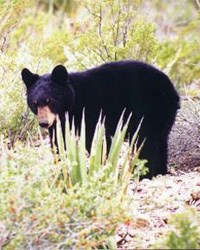
Dave Onorato Black Bears Head South Researchers at Big Bend National Park have documented a remarkable migration of Black Bears from the park into Mexico. Only time will tell whether some of the bears return. It is clear, however, that the migration is a setback to recovery of the bear population, which had been progressing well over the past ten years. The natural re-colonization by black bears of their historic habitat in the Big Bend region is one of the major events of the park’s 55-year history. Wiped out in the Big Bend region by predator control and sport hunting efforts prior to the park’s 1944 establishment, black bears persisted in remote mountain ranges of northern Mexico. In the late 1980’s, park visitors began seeing a small number of bears in the Chisos Mountains, a result of natural re-colonization. The population grew to at least 30 animals in early 2000. A research project was initiated in 1998 to provide park managers with essential data required to preserve the bear population and prevent bear/human conflicts. The study includes tracking radio-collared bears to document their movements. By late summer 2000, fifteen bears were being tracked by researchers. In September, researchers were perplexed that many of the bears were not to be found in their traditional ranges within the park. To locate the wayward bruins, scientists and the park pilot began making flights outside the park in an attempt to pick up radio signals. Soon the mystery was solved. In apparent response to poor food availability due to extended drought conditions, the bears had set off on long journeys away from Big Bend in order to nourish themselves in preparation for the approaching winter denning period. Unfortunately, the travelers faced many hazards on their journeys through harsh desert and mountain terrain. Fifteen bears were being tracked in late summer 2000. By late fall, eight had headed south, two remained in the park, and the whereabouts of five was unknown. The movement created serious questions about the future of Big Bend’s new and celebrated bear population. How many bears were left in the park? Would the migrants survive their dangerous journeys and return to the park? Would a rural Mexican population view bears as predators upon their livestock? Several of the bears trailed small cubs. . . could they possibly survive? A summary of research observations includes the following discoveries: One bear never made it to the border. An adult female died a short distance north of the Rio Grande. She had lost one of her two cubs several weeks earlier. The remaining cub apparently died too. Eight bears successfully crossed the Rio Grande. A young female traveled 60 miles to the Sierra del Carmen, stayed a month, returned to the Chisos in six days, and promptly embarked to the west, where she died in Mexico, southwest of Lajitas, Texas. Her journey was over 90 miles! Another young female moved sixty miles from her home territory and remained through the fall in the Sierra Encantada, southeast of the park beginning the risky return trek in November. By late November, three others had died in the migration, bringing the number of known deaths to five. Cooperative efforts with Mexican authorities were underway to determine the causes of death. Three remained alive in Mexico. Two remained in Big Bend National Park, and the whereabouts of five others was unknown. Weekly flights are scheduled to search for the wayward bears. And the question remains. What will be the fate of the Big Bend bears? Although bears do still remain in the park, compared to previous years, the number of sightings has drastically declined. It seems that only a vestige of the population remains. Only one of the four females with cubs of the year was known to have died. While other cubs may have been lost, these reproducing females are the future of the population. Other studies have demonstrated that adult females have a strong tendency to return to home ranges. If this occurs, and future years bring adequate food supplies, there is high potential for re-population of bears in Big Bend. Regardless of the outcome, the bear migration of 2000 has demonstrated first hand the reality that national parks cannot preserve species alone and in isolation. The future of species inside of parks is often dependent upon the greater human society’s commitment to their preservation beyond park boundaries. In recent years great progress has been made in developing interagency and international cooperation, along with increased public and private support for restoring native species. |
Last updated: February 24, 2015
